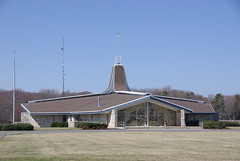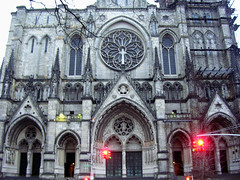Wednesday, March 10, 2010
Friday, February 19, 2010
Attack of the Ugly Babies
This is why Christopher Benson's Hosting the Holy One post on beauty in our churches is not merely a concern for hipster Christian aesthetes, but for anyone who cares about evangelism. Preserving old churches - especially our endangered pre-modern ones - should therefore be considered alongside the prospect of building new ones. (Though it is fair to hope that such restorations will not replicate the violent disorientation and iconoclastic purging to which some well-meaning congregations have unfortunately resorted.) Even when building anew, however, churches should consider constructing in traditional styles. A vanguard of traditional architecture, centered at Notre Dame, is growing, and as the New Liturgical Movement points out, it is not necessarily more expensive to build that way. For more, see the Institute for Sacred Architecture or Philip Bess' excellent book Till We Have Built Jerusalem. Evangelicalism boasts a great variety of architectural styles in its history, and they can be recovered.
 But, some might ask, Isn't the pragmatic modern style of architecture more conducive to pragmatic evangelicalism? Not by a longshot. In An Architecture of Immanence, Mark Torgerson demonstrated the alliance of Protestant liberalism (to which evangelicalism is traditionally opposed) and architectural modernism. His diligently researched book concludes that flat, immanent modern architecture is uniquely suited to mid-century liberal Protestant denial of the supernatural, both of which (he seems to subtly imply) have been outmoded. Before evangelicals build in the modern, pragmatic style, therefore, they might want to consider whether or not the architecture they worship in will be counteracting the sermons preached therein for decades to come. It is impossible for architecture to be neutral.
But, some might ask, Isn't the pragmatic modern style of architecture more conducive to pragmatic evangelicalism? Not by a longshot. In An Architecture of Immanence, Mark Torgerson demonstrated the alliance of Protestant liberalism (to which evangelicalism is traditionally opposed) and architectural modernism. His diligently researched book concludes that flat, immanent modern architecture is uniquely suited to mid-century liberal Protestant denial of the supernatural, both of which (he seems to subtly imply) have been outmoded. Before evangelicals build in the modern, pragmatic style, therefore, they might want to consider whether or not the architecture they worship in will be counteracting the sermons preached therein for decades to come. It is impossible for architecture to be neutral.Still, I'm not too hopeful about the possibilities for an evangelical recovery of traditional architecture. Having spurned the superior resources of Christendom, evangelicals have great difficulty detaching themselves from the dominant culture, and architecture is no exception. In addition, our economic downturn will do much to regenerate that ancient argument (John 12:5) against extravagance in worship, as if the poor were not ministered to by beauty as well. God, needless to say, does not require exquisite buildings, and "wherever two or three or gathered" still, of course, holds true. But as the "easier to have a baby than raise the dead!" dictum catches on, we best brace ourselves for Chick-fil-A church plants (available on Sundays!), or some really ugly babies.
[crossposted at evangel]
Monday, February 8, 2010
And miles to go before we sleep
We have been given a function in the New Covenant, not a form. The modern mall was not so designed as to be an ungodly as possible, but to be as economic and functional as possible. And so it is no wonder to me that a church seeking functionality and feasibility should build a building resembling such functionality...But as we've indicated before, if the point of evangelicalism is, I don't know, evangelism, then McChurches aren't very practical at all.
If a stadium is the mot economical and functional way to include 40,000 people in an experience, then why would not Lakewood church (of which I am no fan) not use a stadium for a different kind of experience for 35,000?
There are reasons besides conformity that modern evangelicals have caved into functional practicality, and it is mainly because it is functionally practical.
Asks another commenter: "How many cathedrals have been built with the purest of intensions and lavished with gilded accoutrements only to end up host to a Godless mass of ritual?" I'm not sure what this "Godless mass of ritual" is - it sounds frightening - but just imagine how much worse it would be in a profoundly ugly building.
Friday, February 5, 2010
Filling the Void
Then, Professor Kourelis, that exemplary steward of our irreplaceable ecclesial heritage, seeing the lack of posting here, went ahead and planned an entire course on Lancaster churches, and launched a new blog!
As if that wasn't enough, my friend Kerry, currently touring the country with a choir, started sending me photographs of the amazing churches he's encountered, such as Cram's Covenant Presbyterian in Charlotte. Here's the plan, here's the reality.
There's too much unappreciated beauty out there. I have not posted lately not due to a paucity of encounters, but due to my not knowing how to digest the many that I've had. First there was a streetside church in Newark (people seemed rather puzzled that I photographed it), then a Long Island mansion that has become a convent (I didn't even get the name), or Cram's Byzantine Christ Church, St. Bartholomeuw's, which the unprecedented dome and rose that I could only get by laying the camera on the pew for a 30 second exposure, not to mention the Tranfiguration apse and side chapel. And don't get me started on my trip to Judson Memorial this Sunday, where I was able to go in and see the LaFarge windows, in a McKim Mead and White setting, with Augustus Saint-Gaudens sculpture at the front for good measure. A triple threat. Perhaps I'll post some of my favorites from these encounters in the weeks to come.
And yet, it's serendipitous that we've been dormant, seeing all who've joined in the task. Highlighting the endangered churches in the American architectural ecosystem is too important of a project to do alone. We shall persist!
Thursday, December 31, 2009
Tuesday, October 27, 2009
Thursday, October 22, 2009
The White Dove of the Desert

San Xavier del Bac
Originally uploaded by millinerd
The White Dove being San Xavier del Bac. There is just too much to tell about my trip Southwest. I found the trip confirmed this blog's motto in two ways: It is all here anyway, and planes, especially domestic ones, are indeed tedious.
Friday, October 9, 2009
Tuesday, August 25, 2009
When They Begin Demolition Of Your Church
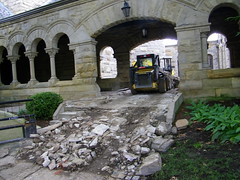 OK, that’s a bit over-dramatic. More like: When They Begin Demolition At Your Church. We take a few weeks each summer to visit other churches: to broaden our worship experiences, to hear certain ministers preach, to refresh memories. This is satisfying and, I think, valuable. There is always a twinge, knowing that we are missing the worship we cherish so much. And, our three associate pastors are in the pulpit much of the time in July and part of August, and they are all excellent preachers.
OK, that’s a bit over-dramatic. More like: When They Begin Demolition At Your Church. We take a few weeks each summer to visit other churches: to broaden our worship experiences, to hear certain ministers preach, to refresh memories. This is satisfying and, I think, valuable. There is always a twinge, knowing that we are missing the worship we cherish so much. And, our three associate pastors are in the pulpit much of the time in July and part of August, and they are all excellent preachers.And so, it was with anticipation that I walked up Westminster Avenue toward Shadyside Church and that sweet encounter with God’s Grace. I regretted that my wife had to attend a rare Sunday meeting at work. I saw the orange fencing and blue dumpster from a distance. I was about to steel myself when I recognized a young couple we know bringing their daughter for baptism. The warmth of that greeting was still with me when I turned and saw the rubble and machines in what had been the peaceful cloister/courtyard between the church and chapel.
I had been expecting, even looking forward to, the beginning of the renovation that emerged from the vision of Building Community for our church. I told myself that it was excitement, not anxiety, that attracted the butterflies to my stomach. I tried to stave off both by documenting the scene in photographs. The blur in half shots belied my sentiments. Even so, I was able to picture the bright, open atrium that will be the church’s “living room,” where we welcome strangers and relax with our church family.
Inside the sanctuary, the sight of old friends and a good crop of visitors settled me. Three chimes and the processional hymn brought my focus to worship. I did not try to put demolition/construction out of my mind. Our sermon was titled “Praying Your Renovation,” with the text describing Nehemiah, mourning the need to rebuild Jerusalem’s walls, which led him to pray. Our Pastor, Craig Barnes, as he always does, was speaking the subtext of scripture into our lives. Our congregation and its leaders had discerned God’s will to include changing our walls to become a place of greater hospitality, for visitors, for members, for those we have the privilege to serve.
Craig spoke about the presenting issue: the anxiety and inconvenience of a construction project. Then he invited us to consider those parts of our lives that need renovation: a relationship, a career, a health concern. Prayer drives our plans to become a part of God’s vision for our lives and for those he wants our lives to reach.
I came away reminded that bringing my anxieties before God rarely causes the anxiety-producer go away. There are times when the things I worry about actually happen – sometimes they are worse than I feared. Faith is trusting that God is ready to redeem every situation with his perfect vision, in his perfect time. And, lest faith become a palliative, Craig’s charge to us was bracing: God’s plans always include change.
Tuesday, July 28, 2009
Boston Apotheosis
As I flew back to North America, therefore, I couldn't help but think I was returning to the land of the naked church. During an all too brief trip in Boston, I braced myself for Puritanism. Harvard's main chapel was a fitting expression. My insistence that Protestant iconoclasm is a dangerous thing, in addition to being completely missed by Christianity Today (who - how could they? - puffed the same Vineyard church I criticized, lending a whole new level of meaning to Our Lady of Pity), was confirmed at Harvard. There, in the beautiful but bare central campus chapel, our tour guide had us sit down for what could only be described as a sermon. He explained to us, rather passionately, that chapel doesn't really mean anything to Harvard students because Harvard preaches... sorry, make that "values" pluralism.
At any rate, few things could have prepared me for what I can only call my Boston apotheosis. Despite a good many trips to that famed city, I had the embarrassment of having never visited Trinity Church. But I somehow missed it on my way through Back Bay, and ending up on Boston Common (onetime home of an Anglican hermit), where I decided to take the Freedom Trail tour again. An immersion into Puritan Boston proved another confirmation of my "land of the naked church" theory. Towards the end of the day, I bought a map and made my way to Trinity. I approached at the high noon of church photography (just before sunset), and the impression was overwhelming. Copley Square shows the land of the naked church gloriously clothed (well, sort of).
Trinity Church was like an invading Romanesque spaceship that landed in Puritan Boston to wreak medieval havoc. As I enjoyed the interior tour, I couldn't help but think that just as Justinian, after building Hagia Sophia, could exclaim, "O Solomon, I have surpassed thee," so Richardson and LaFarge might have been justified in exclaiming, tongue in cheek of course, "O Justinian, I have surpassed thee." A window within suggests the same. Having secured this beachhead of Boston decoration at Trinity, the assault continued across the street at the marvelously Ruskinian Old South Church. And let's not even get started on the Boston Public Library, the flagrantly luxurious celebration of McKim, Mean and White, capped with the career triumph of one who is certainly a contender for finest American painter status, John Singer Sargent. How telling to the state of American art history that the theological import of this work has been only lately brought to light.
The glory days of American architecture before modernism can perhaps be best understood on that square in Boston: The fabulously financed revenge of the medieval on the Puritanism that tried to escape it. Still, my point that whitewashing walls leads to whitewashed doctrine is not always applicable. One cannot, for example, suggest that Trinity is a bastion of classical Christianity, whereas the perfectly plain Park Street Church is much closer to earning that distinction. When it comes to theological destiny, there are much more determinative factors that art and architecture; but that said, art and architecture sure can help - the ideal should be form and content, not or.
Monday, June 8, 2009
Friday, June 5, 2009
Tuesday, May 26, 2009
After Immanence

I've found Mark Torgerson's irenic explication of modernist church design, An Architecture of Immanence, a helpful resource, especially the wonderful appendixes. Here's an online review. What the reviewer does not mention is that at the end of the book, Torgerson - who is deeply sympathetic to modernism - admits its failure, and points to the need for some kind of return to traditional architecture. The assumptions of liberal Protestant theology that were yoked to modernism, in Torgerson's words, "have been proven false." At the risk of self-linking, I like to think this puts Torgerson in agreement with Bess and Glazer.
You can read the entire conclusion at Google books, which is well worth doing.
Friday, May 8, 2009
The Pulpit

Wednesday, April 1, 2009
St James-the-Loss ?
The founders of the Cambridge-Camden Society believed the antidote to the evils of the 19th century was a return to medieval piety. Their early thrust was restoration of the medieval architectural setting for worship in the Anglican Church. Their generosity of advice was paired with their prickly attitude toward anyone who did not accept it wholeheartedly. Their zeal extended to “the colonies” which resulted in one of the most charming and influential churches in America, St. James-the-Less in Philadelphia. (The Society lives on with only a short break in continuity as The Ecclesiolgoical Society.)
In response to a request to the Society for design assistance with their Episcopal church, the Pennsylvania congregation received measured drawings of a 13th century parish church, St. Michael’s, Longstanton, Cambridgeshire. The congregation faithfully reproduced the model high above the Schuylkill River, changing only the length of the structure and selection of stone in the 1846 construction.
In fine ecclesiological fashion, the nave and long chancel are clearly expressed in the exterior massing of the building. The later addition of the sacristy only enhanced the picturesque composition – a guiding principal of the increasingly archeological Gothic Revival. The long steep rooflines, as seen on the south porch entrance enhance the sense of shelter and worshipful repose.
On a recent visit, the cold, drizzly day seemed appropriate to the disuse into which St. James-the-Less has fallen in the past several years. This is not to be blamed on neglect. The too-familiar story is of a congregation, rejecting the theological trajectory of the Episcopal Church, disaffiliated itself from the denomination. The odd result of legal wrangling held that the congregation owned the church building, but held it in trust for the diocese, who evicted them. We should not force too much irony on the fact that the congregation now worships in a nearby cemetery chapel – as much of charm of St. James-the-Less is its setting among gravestones, old and not-so-old.
Given the situation, we had no expectation that we could even gain access for exterior photography. Happily, we were greeted by a young man associated with another diocesan church, who was waiting for visiting group. He offered to let us tag along with a small group of clerics from the Reformed Catholic Church.
That ushered us into the church where darkness and sight lines obstructed by columns and by a rich rood screen were a reminder that lay participation in the medieval mass, celebrated in the divided chancel, was decidedly passive. Electric lighting struggled against the shadows, while the discoloration of the arcade springing was attributed to match strikes for the original chandeliers. Discolored stone on the pulpit indicated a hand rest for the deliverers of countless sermons.
In addition to the pulpit, the expected liturgical centers were there, altar, lectern, font, side chapel. The stained glass was obviously there to set a mood and tell a story rather than provide illumination.
St James the Less has been assumed as a mission by St Mark’s, the historic John Notman church in Center City Philadelphia. They should have experience and skill in preserving and using a historic structure. Let’s hope that they can do that. Nothing leads to loss like disuse. Nothing preserves like an active, resident congregation. Loss or damage of St. James-the-Less would be tragic from an architectural standpoint. From a spiritual standpoint, good stewardship demands a Kingdom use of this treasure.
UPDATE: I had a pleasant email exchange with Father Ousley, rector of the congregation formerly at St James. He confirms that the attribution of marks on the column springing to match strikes is in a written church history. However they have determined that the discoloration is from greens hung at Christmas. The congregation presently worships at the chapel at West Laurel Hill Cemetery. He also relates, "West Laurel Hill was founded by the same gentlemen who founded Laurel Hill Cemetery, and gave St James the first part of the land on which it is built. A nice historical touch."
Monday, March 23, 2009
Europe and then some
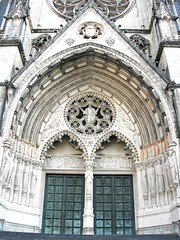
saint john the divine 1/5
Originally uploaded by musiquegirl
Just to prove this blogs motto, "it's all here anyway," here are Ghiberti's North American doors. Cram would have none such copying, by the way, hence he commissioned impressive new bronze doors (depicted above) for St. John the Divine. Some nice details of the south New Testament door here.
.
Incidentally, Maureen Mullarkey's article on the North American tour of the original Gates of Pardise is a tour de force.
Thursday, March 19, 2009
Saturday, March 14, 2009
Flannery's Church
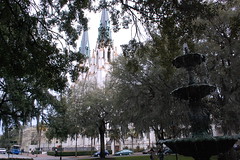
Cathedral of St. John the Baptist, Savannah
Originally uploaded by millinerd
John H., a friend who was driving through Savannah, sent in this shot (with info) of the home church of Flannery O'Connor. There is some nice exegesis of the interior at the church website, but I thought the menacing trees in John's photo was very O'Connoresque.
Friday, March 6, 2009
Cathedrals Gone Wild
Call me prudish, but I thought St. Bernard's stained glass vision was a bit much. Not to mention Ruth seducing Naomi in the stonework. Then there's the matter of the pin-up tympanum on the National Cathedral in Washington D.C. It will come as no surprise that these are both Episcopal Cathedrals.
I'm well aware that salacious imagery on churches has a long history, and I'm all for a nuanced appreciation of Bernard's Song of Songs sermons, but about these depictions I just don't know. Yes, the Christian tradition teaches that the body is good - but it also teaches that we aren't. Hence, you can get away with things in the realm of literature that you can't get away with in art. Still, I would represent my level of suspicion in regard to these representations as a yellow light, not necessarily a red one - though I'm open to being convinced otherwise.
What I can say is that at least at the Saint John the Divine portal, most will be distracted by a more remarkable carving, the twin towers falling in an imagined apocalyptic scene, carved in... wait for it... 1997.




